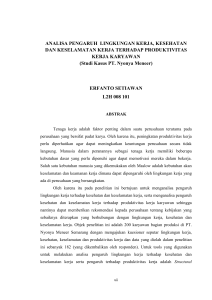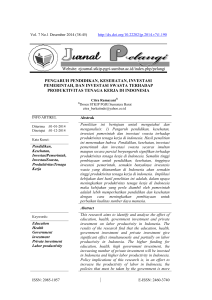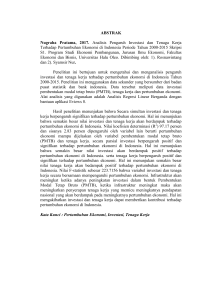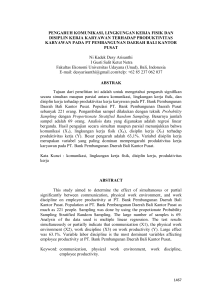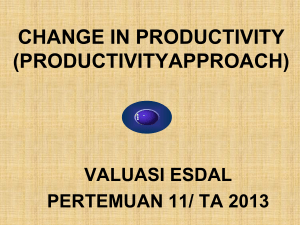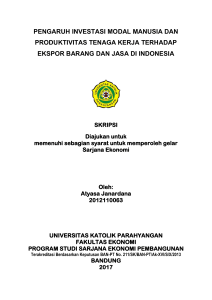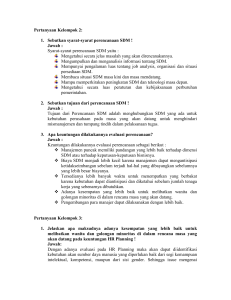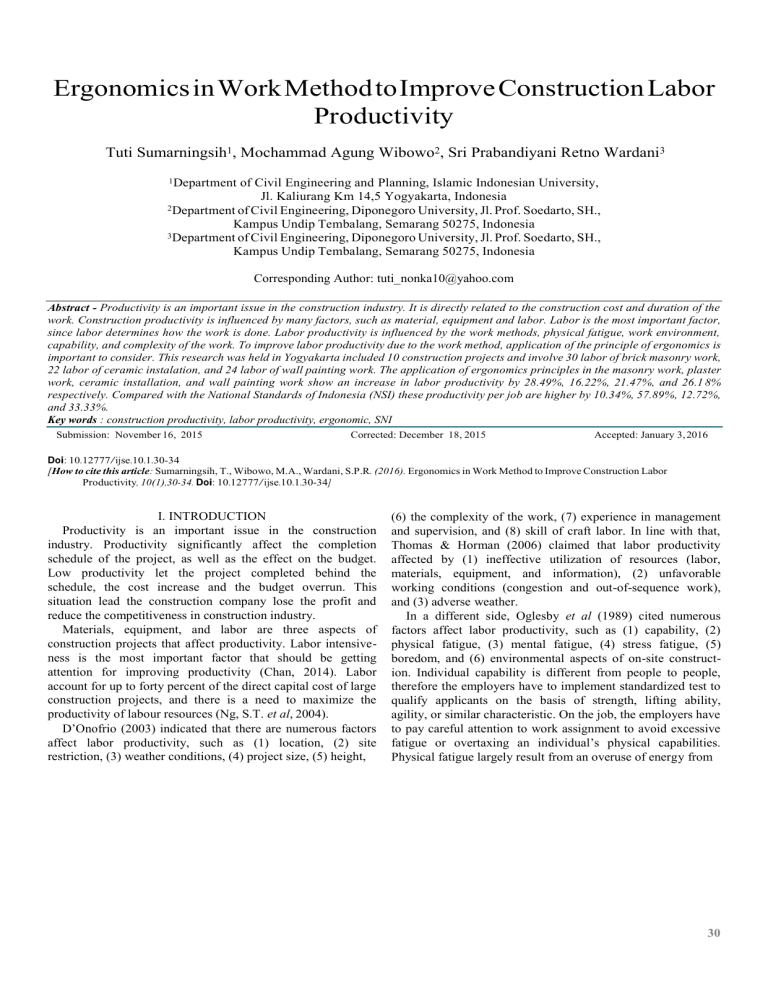
Ergonomics in Work Method to Improve Construction Labor Productivity Tuti Sumarningsih1, Mochammad Agung Wibowo2, Sri Prabandiyani Retno Wardani3 1 Department of Civil Engineering and Planning, Islamic Indonesian University, Jl. Kaliurang Km 14,5 Yogyakarta, Indonesia 2 Department of Civil Engineering, Diponegoro University, Jl. Prof. Soedarto, SH., Kampus Undip Tembalang, Semarang 50275, Indonesia 3 Department of Civil Engineering, Diponegoro University, Jl. Prof. Soedarto, SH., Kampus Undip Tembalang, Semarang 50275, Indonesia Corresponding Author: [email protected] Abstract - Productivity is an important issue in the construction industry. It is directly related to the construction cost and duration of the work. Construction productivity is influenced by many factors, such as material, equipment and labor. Labor is the most important factor, since labor determines how the work is done. Labor productivity is influenced by the work methods, physical fatigue, work environment, capability, and complexity of the work. To improve labor productivity due to the work method, application of the principle of ergonomics is important to consider. This research was held in Yogyakarta included 10 construction projects and involve 30 labor of brick masonry work, 22 labor of ceramic instalation, and 24 labor of wall painting work. The application of ergonomics principles in the masonry work, plaster work, ceramic installation, and wall painting work show an increase in labor productivity by 28.49%, 16.22%, 21.47%, and 26.1 8% respectively. Compared with the National Standards of Indonesia (NSI) these productivity per job are higher by 10.34%, 57.89%, 12.72%, and 33.33%. Key words : construction productivity, labor productivity, ergonomic, SNI Submission: November 16, 2015 Corrected: December 18, 2015 Accepted: January 3, 2016 Doi: 10.12777/ijse.10.1.30-34 [How to cite this article: Sumarningsih, T., Wibowo, M.A., Wardani, S.P.R. (2016). Ergonomics in Work Method to Improve Construction Labor Productivity, 10(1),30-34. Doi: 10.12777/ijse.10.1.30-34] I. INTRODUCTION Productivity is an important issue in the construction industry. Productivity significantly affect the completion schedule of the project, as well as the effect on the budget. Low productivity let the project completed behind the schedule, the cost increase and the budget overrun. This situation lead the construction company lose the profit and reduce the competitiveness in construction industry. Materials, equipment, and labor are three aspects of construction projects that affect productivity. Labor intensiveness is the most important factor that should be getting attention for improving productivity (Chan, 2014). Labor account for up to forty percent of the direct capital cost of large construction projects, and there is a need to maximize the productivity of labour resources (Ng, S.T. et al, 2004). D’Onofrio (2003) indicated that there are numerous factors affect labor productivity, such as (1) location, (2) site restriction, (3) weather conditions, (4) project size, (5) height, (6) the complexity of the work, (7) experience in management and supervision, and (8) skill of craft labor. In line with that, Thomas & Horman (2006) claimed that labor productivity affected by (1) ineffective utilization of resources (labor, materials, equipment, and information), (2) unfavorable working conditions (congestion and out-of-sequence work), and (3) adverse weather. In a different side, Oglesby et al (1989) cited numerous factors affect labor productivity, such as (1) capability, (2) physical fatigue, (3) mental fatigue, (4) stress fatigue, (5) boredom, and (6) environmental aspects of on-site construction. Individual capability is different from people to people, therefore the employers have to implement standardized test to qualify applicants on the basis of strength, lifting ability, agility, or similar characteristic. On the job, the employers have to pay careful attention to work assignment to avoid excessive fatigue or overtaxing an individual’s physical capabilities. Physical fatigue largely result from an overuse of energy from 30 short-term overexertion and the long-term requirements of the body. Managers and supervisors in construction project often have deadline that demand high energy input. They are often faced with conflicting demand from workers on the one hand and from higher-level management on the other. For workers, there may be cramped work space, noise, and heat. In such situation the heartbeat increases and those affected fell fatigued, that suffer productivity (Oglesby et al, 1989). Manuaba and Vanwonterghem (1996) classified physical fatigue by measure the differences between work pulse (heartbeat) and rest pulse, compare to the differences between maximum pulse and rest pulse, as cardiovasculair load (CVL). Maximum pulse for male is (220 – age) heartbeats per minute. The percentage of CVL is presented in this formula : 100 x (Work Pulse – Rest Pulse) % CVL = -----------------------------------------Maximum Pulse – Rest Pulse It is difficult to measure mental work load as a first step toward assessing its effect on fatigue and productivity. One study found that mental loads increased the respiration rate and heartbeat by 15% and that substansial decrement in efficiency occurred (Oglesby et al, 1989). Much construction is carried on the open, so productivity can be strongly affected by adverse environmental conditions such as heat, rain, humidity, and noise. Physical fatigue, mental fatigue, and environmental aspects mentioned by Oglesby etal (1989), and the other side, location, weather conditions, and ineffective utilization of resources cited by D’Onofrio (2003), Thomas and Horman (2006), carried the thought of attempt to improve labor productivity by pay sufficient attention on the method of work. In this way, ergonomics is an important aspect that must be considered to improve labor performance. Labor productivity is the most difficult aspect to predict (D’Onofrio, 2003), because it is influenced by many factors and there is no standard of work method is applied. Labor doing the work in various ways. Some of the methods indicate inefficient movement and inefficient work time, consume a lot of energy. The work methods also not respect to the convenience condition to the labor, often cause muscle fatigue even musculosceletal disorders. Such working methods led the labor productivity is not optimum. To improve labor productivity due to the work method, application of the ergonomics principles and motion economics principles must be considered. Ergonomics is the ability to apply information regarding human characters, capacities, and limitation to the design of human task, machine system, living spaces, and environment so that people can live and work safely, comfortably and efficiently (Mittal et al, 2013; Shoubi et al, 2013). Motion economics principles is a set of rules and suggestions to improve manual work and reduce fatigueand unnecessary movements do by worker. It can lead reduction in the work related trauma. Ergonomics can be defined as “the branch of science that concern with the achievement of optimal relationship between workers and their work environment” (Tayyari and Smith, 1997). It deals with the assessment of the human’s capabilities and limitation (biomechanics and anthropometry), work and environmental stresses (work physiology and industrial psychology), static and dynamic forces on the human body structure (biomechanics), fatigue (work physiology and industrial psychology), and design of workstations and tools (anthropometry and engineering). Ergonomics is the study of work laws. Its goal is to fit work to individuals, as opposed to fitting workers to the work, through developing knowledge that results in efficient adaption of work methods to the individual’s physiological and psychological characteristic. Therefore, the objective of ergonomics applied is to identify and alleviate those work stresses that adversely affect the health, safety and efficiency of workers (Tayyari and Smith, 1997). In other words, the ergonomist’s task is first to determine the capabilities of the workers and then to attempt to build a workable system around these capabilities (Oborne, 1987; Musidah and Syakhroni, 2010). Occupational ergonomics strive to review work systems and modify them to minimize occupational stresses. Ergonomics principles can be used in the following industrial applications (Tayyari and Smith, 1997): a. Design, modification, replacement and maintenance of equipment for enhanced productivity, the work-life and product quality. b. Design and modification of work spaces and workplace layout for ease and speed of operation, service and maintenance. c. Design and modification of work methods, including automation and task allocation between human operators and machine. d. Controlling physical factors (e.g., heat, cold, noise, vibration, and light) in the workplace for the best productivity and safety of employees. II. MATERIAL AND METHODS This study is part of a dissertation research in the Doctoral Program in Civil Engineering Diponegoro University of Semarang, Indonesia. The objectives of this research is to study how the implementation of ergonomics and motion economics principles can improve construction labor productivity. Brick masonry and plaster worker, wall painter, and ceramic installation worker in building construction were chosen as samples, since the productivity of these tasks are dominantly based on labor capability. Brick masonry work was choosen by consideration that almost housing in Jawa, a most densely populated area in Indonesia, is build of brick masonry. Painting and ceramic installation were choosen since the tasks must be done by people work that can not be replaced by machine. The method of this research is field base experience. Exist labor work method was documented by digital camera recorder, and then the pictures analyzed by ergonomics and motion economics principles. The next step is design work method by applied ergonomics and motion economics principles to improve productivity. The labor productivity by exist work method then compared to the labor productivity resulted by improved work method. Standard productivity of construction work formulated in SNI (Standar Nasional 31 Indonesia) is used as benchmark. The test of work load is done by investigated the level of cardio vasculair load (CVL) of labor on exist work condition and the CVL on improved work method to be compared. The research was held in Yogyakarta included 10 construction projects, involved 30 labor of brick masonry work, 22 labor of ceramic installation work, and 24 labor of wall painting work. All of them are men, age of 25 – 40 years old, at least 2 years experienced, normal posture of Indonesian people (160 -170 cm height, 60 – 70 kg weight), and good performance referred by foreman. Several assumptions were taken in this research, such as: (1) The labor physical and psychological condition in the exist work method is relatively similar to the labor physical and psychological condition in the improved work method. (2) The work quality of exist work method is relatively similar to the work quality of improved work method. (3) Labor productivity observed in this research reflect average productivity of labor in general. Figure 2. Sitting on low bench III. RESULT AND DISCUSSIONS In this research ergonomics analysis was done on labor work method in three aspects: (1) Position of the body at work (2) Environment of workplace (3) Work device support Labor work in different position of the body, depend on the height of the work area to be done. There are four body positions of the labor at work : squat, bent, stand up, and sit down. Each of these positions consume different energy and causes musculosceletal fatigue in different level. Regarding to ergonomic principle, squat position and bent position are bad positions, because these positions consume much energy and causes severe musculosceletal fatigue. The modification of work method to alleviate squat position is done by arrange labor worked by sitting on low bench (Figure 1 and Figure 2), and placed material on the table to avoid bent position. Placing material on the table eliminate unnecessary movement as well, therefore meet the principle of motion economic (Figure 3 and Figure 4). Figure 3. Bent Position Figure 4. Material Placed on Table Figure 1. Squat Position The environment of workplace varies between hot condition by sun rise exposure and shady condition under the roof. The exposure of heat will increase heart beat, decrease breath, and cause labor motion slow down. Labor work on the scaffolding will slow down the motion also, as there is limited workplace that make labor fell not so save and not so convenience. 32 The three aspects (position of the body, environment of workplace, and work device support) influence labor productivity. Observation was done in two conditions: exist work method and improved work method. Table 1 shows observation of Labor 1 on brick masonry in exist work method. Tabel 2 shows observation of Labor 1 in improved work method. Tabel 1. Ergonomic Observation and Productivity Level on Improved Work Method OBSERVATION 1 Work job : Brick Masonry Location : Privat House, Prambanan – Bantul Date Time of Observation 09.00 - 09.35 1 11.15 - 11.45 13.30 - 14.00 2 08.45 - 09.15 10.30 - 11.00 14.00 - 14.30 Body Position Sit on bench Sit on bench Stand up Stand Up Stand Up Sit on scaff Stand up on Scaffolding Sit on scaff Stand Up Stand Up Stand Up Worker : Labor 1 Age : 36 th Observation Environment Of Workplace Shady Supporting Device On Ground Shady Rest Pulse Work Pulse % CVL 63 87 19,83 Productivity (m2/30 mnt) 0,750 On Ground 62 86 19,83 0,815 Shady On Ground 63 87 19,89 0,775 Shady Scaffolding 63 88 20,66 0,710 Shady Scaffolding 63 89 21,48 0,770 Low Hot Average Scaffolding 64 63 90 88,5 21,48 20,52 0,760 0,763 Table 2. Ergonomic Observation and Productivity Level on Exist Work Method OBSERVATION 1 Work job : Brick Masonry Location : Bantul General Hospital Date Time of Observation 08.30 - 09.00 1 10.45 - 11.15 14.30 - 15.00 2 08.45 - 09.15 10.30 - 11.00 3 14.15 - 14.45 08.50 - 09.20 10.45 - 11.15 14.10 - 14.40 Average Body Position Squat Squat Back Bend Stand Up Back Bend Back Bend Stand Up Back Bend Stand Up Back Bend Stand Up Squat Squat Back Bend Stand Up Worker Age : Labor 1 : 36 th Rest Pulse Work Pulse % CVL 62 85 19,66 0,675 Observation Environment Of Workplace Shady Supporting Device Scaffolding Shady Scaffolding 63 85 18,18 0,615 Hot Scaffolding 63 88 20,66 0,655 Shady Scaffolding 63 82 15,70 0,610 Shady Scaffolding 63 86 19,00 0,665 Low Hot Shady Low Hot Scaffolding Scaffolding Scaffolding 64 62 63 86 86 87 18,33 20,57 21,70 0,650 0,680 0,710 Hot Scaffolding 63 62,89 95 86,66 26,45 20,03 0,715 0,664 Productivity (m2/30 mnt) 33 It can be seen from Table 1 and Table 2, the percentage of CVL increase from 20,03 in exist work method to 20,52 in improved work method, while the productivity increase from 0,664 m2/30 minutes to 0,763 m2/30 minutes. The increase of productivity is reached as labor worked more rapidly as they felt more convenient with the improved work method. The complete observation result and analysis is presented in Table 3 . Increase Productivity (%) V. CONCLUSION At this time the implementation of ergonomic principles have not been seriously considered in construction project, though the ergonomic way of work will increase productivity and improve worker health as well. The result of this research prove that labor productivity achieved by the application of ergonomic work method increased significantly, especially for job that rely on skill and physical capability of labor. 28,49 ACKNOWLEDGEMENTS The author gratefully acknowledge Islamic Indonesian University (UII) for giving financial support for this research project. Table 3. The Increase of Labor Productivity Lead by Applied Ergonomic Principle on Work Method No Work Observed 1 Brick Masonry Plaster Wall painting Ceramic Fixing 2 3 4 No Work Observed 1 Brick Masonry Plaster Wall painting Ceramic Fixing 2 3 4 Productivity (m2/hour) Exist Work Improved Methode Work Method 1,3796 1,7727 1,3766 2,1185 1,5999 2,8735 16,22 21,47 0,4901 0,6225 26,18 Productivity (m2/hour) Exist Work Improved Methode Work Method 1,3796 1,7727 labor productivity in all region of Indonesia that have large skill variation, so SNI has to accommodate labor in regions with low skill, while labor observed in this research come from Yogyakarta that have high level productivity compare to the other region. Increase Productivity (%) 28,49 1,3766 2,1185 1,5999 2,8735 16,22 21,47 0,4901 0,6225 26,18 The productivity of improved work methods on Table 3 was obtained from selected labor with prime condition. To find the average productivity that meet general condition of all construction labor, these productivity is corrected by 10%. The comparison between observed labor productivity to the SNI (Indonesian National Standardization) as the benchmark of this research is presented in Table 4. Table 4 The Comparison of Labor Productivity to the SNI No Work Observed Productivity (m2/hour) 1 2 3 4 Brick Masonry Plaster Wall painting Ceramic Fixing Observed 1,60 1,45 2,57 0,56 SNI 1,45 0,95 2,28 0,42 Productivity Differences from SNI m2/hour % 0,15 10,34 0,55 57,89 0,29 12,72 0,14 33,33 The differences between observed productivity in this research to the SNI occurs because SNI is the standard for 34 REFERENCES Chan,P, (2014) Factors Affecting Labour Productivity in The Construction Industry, www.arcom.ac.uk (accesed on 20 April 2014) D’Onofrio, M.F., (2003) Making Loss of Productivity Claims in Real Estate Projects, paper of seminar sponsored by the Construction Division of the Public Contract Section of the American Bar Association http://files.alicle.org/thumbs/datastorage/lacidoirep/articles/PREL_PREL0407- DONOFRIO_thumb.pdf Manuaba, A. & Vanwonterghem, K., (1996) Final Report : Improvement of Quality of Life : Determination of Exposure Limits for Physical Strenuous Task Under Tropical Condition. Joint Research Project Indonesia-Belgium. Departement of Physiology. University of Udayana, Denpasar. Mittal, A., Sharma, HK., and Mittal, K., (2013) Ergonomic Risk Control in Construction Industry – A Literature Review, International Journal of Emerging Research in Management & Technology, Vol. 2, 28 – 33. www.ermt.net Masidah, E. and Syakhroni, A, (2010) “Analisa Lama Waktu Istirahat Berdasarkan Beban Kerja di UD TT Jaya Sayung Demak, http://cyber.unissula.ac.id , (accesed on 15 March 2014). Ng, S.T. et al, (2004) Demotivating Factors Influencing the Productivity of Civil Engineering Projects. International Journal of Project Management Vol. 22(2), 139-146. http://eprints.qut.edu.au/4136/1/4136.pdf Oborne, D.J., (1987), Ergonomics at Work, John Wiley & Sons, New York Oglesby, C.H. et al (1989) Productivity Improvement in Construction, McGraw-Hill Book Company, New York Shoubi, M.V., Barough, A.S., Rasoulijavaheri, A., (2013) Ergonomics Principles and Utilizing It As A Remedy For Probable Work Related Injuries In Construction Projects, International Journal of Advances in Engineering & Technology, Vol. 6 (1), 232 – 245, www.e-ijaet.org Tayyari, F, Smith, J, (1997), Occupational Ergonomics, Principles and Application, Chapman & Hall, London Thomas, H.R. Horman, M.J. (2006) Fundamental Principles of Workforce Management, Journal of Conctruction Engineering and Management, Vo.132 (1) 97 – 104. 35 Ergonomi dalam Metode Kerja untuk Meningkatkan Produktivitas Tenaga Kerja Konstruksi Abstrak - Produktivitas merupakan masalah penting dalam industri konstruksi. Ini terkait langsung dengan biaya konstruksi dan durasi pekerjaan. Produktivitas konstruksi dipengaruhi oleh banyak faktor, seperti material, peralatan, dan tenaga kerja. Tenaga kerja adalah faktor yang paling penting, karena tenaga kerja menentukan bagaimana pekerjaan dilakukan. Produktivitas tenaga kerja dipengaruhi oleh metode kerja, kelelahan fisik, lingkungan kerja, kemampuan, dan kompleksitas pekerjaan. Untuk meningkatkan produktivitas tenaga kerja karena metode kerja, penerapan prinsip ergonomi penting untuk dipertimbangkan. Penelitian ini dilaksanakan di Yogyakarta termasuk 10 proyek konstruksi dan melibatkan 30 tenaga kerja pekerjaan batu bata, 22 tenaga instalasi keramik, dan 24 tenaga kerja pekerjaan pengecatan dinding. Penerapan prinsip-prinsip ergonomi dalam pekerjaan batu, pekerjaan plester, instalasi keramik, dan pekerjaan melukis dinding menunjukkan peningkatan produktivitas tenaga kerja masing-masing sebesar 28,49%, 16,22%, 21,47%, dan 26,18%. Dibandingkan dengan Standar Nasional Indonesia (NSI) produktivitas ini per pekerjaan lebih tinggi sebesar 10,34%, 57,89%, 12,72%, dan 33,33%. Kata kunci: produktivitas konstruksi, produktivitas tenaga kerja, ergonomis, SNI I. PENDAHULUAN Produktivitas adalah masalah penting dalam industri konstruksi. Produktivitas secara signifikan mempengaruhi jadwal penyelesaian proyek, serta pengaruhnya terhadap anggaran. Produktivitas yang rendah membuat proyek selesai di belakang jadwal, kenaikan biaya dan anggaran dibanjiri. Keadaan ini menyebabkan perusahaan konstruksi kehilangan laba dan mengurangi daya saing di industri konstruksi. Bahan, peralatan, dan tenaga kerja adalah tiga aspek proyek konstruksi yang memengaruhi produktivitas. Intensitas tenaga kerja adalah faktor terpenting yang harus mendapatkan perhatian untuk meningkatkan produktivitas (Chan, 2014). Tenaga kerja menyumbang hingga empat puluh persen dari biaya modal langsung dari proyek konstruksi besar, dan ada kebutuhan untuk memaksimalkan produktivitas sumber daya tenaga kerja (Ng, S.T. et al, 2004). D'ofofo (2003) menunjukkan bahwa ada banyak faktor yang mempengaruhi produktivitas tenaga kerja, seperti (1) lokasi, (2) pembatasan lokasi, (3) kondisi cuaca, (4) ukuran proyek, (5) tinggi, (6) kompleksitas pekerjaan, (7) pengalaman dalam manajemen dan pengawasan, dan (8) keterampilan tenaga kerja kerajinan. Sejalan dengan itu, Thomas & Horman (2006) menyatakan bahwa produktivitas tenaga kerja dipengaruhi oleh (1) pemanfaatan sumber daya yang tidak efektif (tenaga kerja, bahan, peralatan, dan informasi), (2) kondisi kerja yang tidak menguntungkan (kemacetan dan pekerjaan tidak sesuai urutan) ), dan (3) cuaca buruk. Di sisi yang berbeda, Oglesby et al (1989) mengutip banyak faktor yang mempengaruhi produktivitas tenaga kerja, seperti (1) kemampuan, (2) kelelahan fisik, (3) kelelahan mental, (4) kelelahan stres, (5) kebosanan, dan ( 6) aspek lingkungan dari konstruksi di tempat. Kemampuan individu berbeda dari orang ke orang, oleh karena itu pengusaha harus menerapkan tes standar untuk memenuhi syarat pelamar berdasarkan kekuatan, kemampuan mengangkat, kelincahan, atau karakteristik serupa. Di tempat kerja, pengusaha harus memperhatikan tugas pekerjaan dengan hati-hati untuk menghindari keletihan yang berlebihan atau membebani kemampuan fisik individu secara berlebihan. Kelelahan fisik sebagian besar disebabkan oleh penggunaan energi yang berlebihan aktivitas berlebihan jangka pendek dan persyaratan jangka panjang dari tubuh. Manajer dan pengawas dalam proyek konstruksi seringkali memiliki tenggat waktu yang menuntut input energi yang tinggi. Mereka sering dihadapkan dengan permintaan yang saling bertentangan dari pekerja di satu sisi dan dari manajemen tingkat yang lebih tinggi di sisi lain. Bagi pekerja, mungkin ada ruang kerja yang sempit, kebisingan, dan panas. Dalam situasi seperti itu detak jantung meningkat dan mereka yang terkena dampak lelah, yang menderita produktivitas (Oglesby et al, 1989). Manuaba dan Vanwonterghem (1996) mengklasifikasikan kelelahan fisik dengan mengukur perbedaan antara denyut kerja (heartbeat) dan denyut nadi, dibandingkan dengan perbedaan antara denyut nadi maksimum dan denyut nadi lainnya, sebagai beban kardiovaskuler (CVL). Denyut maksimum untuk pria adalah (220-usia) detak jantung per menit. Persentase CVL disajikan dalam rumus ini : % CVL = 100𝑥 (𝑤𝑜𝑟𝑘 𝑃𝑢𝑙𝑠𝑒−𝑅𝑒𝑠𝑡 𝑃𝑢𝑙𝑠𝑒 𝑀𝑎𝑥𝑖𝑚𝑢𝑚 𝑃𝑢𝑙𝑠𝑒−𝑅𝑒𝑠𝑡 𝑃𝑢𝑙𝑠𝑒 Sulit untuk mengukur beban kerja mental sebagai langkah pertama menuju menilai pengaruhnya terhadap kelelahan dan produktivitas. Satu studi menemukan bahwa beban mental meningkatkan laju respirasi dan detak jantung sebesar 15% dan penurunan substansial dalam efisiensi terjadi (Oglesby et al, 1989). Banyak konstruksi dilakukan di tempat terbuka, sehingga produktivitas dapat sangat dipengaruhi oleh kondisi lingkungan yang merugikan seperti panas, hujan, kelembaban, dan kebisingan. Kelelahan fisik, kelelahan mental, dan aspek lingkungan yang disebutkan oleh Oglesby etal (1989), dan sisi lain, lokasi, kondisi cuaca, dan pemanfaatan sumber daya yang tidak efektif yang dikutip oleh D'Onofrio (2003), Thomas dan Horman (2006), membawa memikirkan upaya untuk meningkatkan produktivitas tenaga kerja dengan memberikan perhatian yang cukup pada metode kerja. Dengan cara ini, ergonomi merupakan aspek penting yang harus dipertimbangkan untuk meningkatkan kinerja tenaga kerja. Produktivitas tenaga kerja adalah aspek yang paling sulit untuk diprediksi (D'ofofrio, 2003), karena dipengaruhi oleh banyak faktor dan tidak ada standar metode kerja yang diterapkan. Buruh melakukan pekerjaan dengan berbagai cara. Beberapa metode menunjukkan gerakan yang tidak efisien dan waktu kerja yang tidak efisien, menghabiskan banyak energi. Metode kerja juga tidak menghormati kondisi kenyamanan persalinan, sering menyebabkan kelelahan otot, bahkan gangguan muskuloskeletal. Metode kerja seperti itu menyebabkan produktivitas tenaga kerja tidak optimal. Untuk meningkatkan produktivitas tenaga kerja karena metode kerja, penerapan prinsip-prinsip ergonomi dan prinsip-prinsip gerak ekonomi harus dipertimbangkan. 36 Ergonomi adalah kemampuan untuk menerapkan informasi mengenai karakter manusia, kapasitas, dan batasan pada desain tugas manusia, sistem mesin, ruang hidup, dan lingkungan sehingga orang dapat hidup dan bekerja dengan aman, nyaman dan efisien (Mittal et al, 2013; Shoubi et al, 2013). Prinsip ekonomi gerak adalah seperangkat aturan dan saran untuk meningkatkan kerja manual dan mengurangi kelelahan dan gerakan yang tidak perlu dilakukan oleh pekerja. Hal ini dapat menyebabkan pengurangan trauma terkait pekerjaan. Ergonomi dapat didefinisikan sebagai "cabang ilmu yang berkaitan dengan pencapaian hubungan optimal antara pekerja dan lingkungan kerja mereka" (Tayyari dan Smith, 1997). Ini berkaitan dengan penilaian kemampuan dan keterbatasan manusia (biomekanik dan antropometri), tekanan kerja dan lingkungan (fisiologi kerja dan psikologi industri), kekuatan statis dan dinamis pada struktur tubuh manusia (biomekanik), kelelahan (fisiologi kerja dan psikologi industri) , dan desain workstation dan alat (antropometri dan teknik). Ergonomi adalah studi tentang hukum kerja. Tujuannya adalah untuk menyesuaikan pekerjaan dengan individu, sebagai lawan untuk menyesuaikan pekerja dengan pekerjaan, melalui pengembangan pengetahuan yang menghasilkan adaptasi yang efisien dari metode kerja dengan karakteristik fisiologis dan psikologis individu. Oleh karena itu, tujuan ergonomi yang diterapkan adalah untuk mengidentifikasi dan mengurangi tekanan kerja yang berdampak buruk pada kesehatan, keselamatan dan efisiensi pekerja (Tayyari dan Smith, 1997). Dengan kata lain, tugas ergonomis adalah pertama-tama menentukan kemampuan pekerja dan kemudian berusaha membangun sistem yang bisa diterapkan di sekitar kemampuan ini (Oborne, 1987; Musidah dan Syakhroni, 2010). Ergonomi pekerjaan berusaha untuk meninjau sistem kerja dan memodifikasinya untuk meminimalkan tekanan kerja. Prinsip-prinsip ergonomi dapat digunakan dalam aplikasi industri berikut (Tayyari dan Smith, 1997): Sebuah. Desain, modifikasi, penggantian, dan pemeliharaan peralatan untuk meningkatkan produktivitas, masa kerja, dan kualitas produk. b. Desain dan modifikasi ruang kerja dan tata letak tempat kerja untuk kemudahan dan kecepatan operasi, layanan, dan pemeliharaan. c. Desain dan modifikasi metode kerja, termasuk otomatisasi dan alokasi tugas antara operator manusia dan alat berat. d. Mengontrol faktor fisik (mis., Panas, dingin, kebisingan, getaran, dan cahaya) di tempat kerja untuk produktivitas dan keselamatan karyawan yang terbaik. II BAHAN DAN METODE Penelitian ini merupakan bagian dari penelitian disertasi pada Program Doktor Teknik Sipil Universitas Diponegoro Semarang, Indonesia. Tujuan dari penelitian ini adalah untuk mempelajari bagaimana penerapan prinsip-prinsip ergonomi dan gerak ekonomi dapat meningkatkan produktivitas tenaga kerja konstruksi. Sampel bata dan pekerja plester, pelukis dinding, dan pekerja instalasi keramik dalam konstruksi bangunan dipilih sebagai sampel, karena produktivitas tugas-tugas ini secara dominan didasarkan pada kemampuan tenaga kerja. Pekerjaan pasangan bata bata dipilih dengan pertimbangan bahwa hampir semua perumahan di Jawa, daerah berpenduduk padat di Indonesia, dibangun dari pasangan bata. Pengecatan dan pemasangan keramik dipilih karena tugas harus dikerjakan oleh orang yang tidak bisa diganti dengan mesin. Metode penelitian ini adalah pengalaman lapangan. Metode kerja buruh yang ada didokumentasikan oleh perekam kamera digital, dan kemudian gambar dianalisis dengan prinsip-prinsip ergonomi dan ekonomi gerak. Langkah selanjutnya adalah merancang metode kerja dengan menerapkan prinsip-prinsip ergonomi dan gerak ekonomi untuk meningkatkan produktivitas. Produktivitas tenaga kerja dengan metode kerja yang ada kemudian dibandingkan dengan produktivitas tenaga kerja yang dihasilkan oleh metode kerja yang ditingkatkan. Produktivitas standar pekerjaan konstruksi dirumuskan dalam SNI (Standar Nasional) Indonesia) digunakan sebagai patokan. Tes beban kerja dilakukan dengan menyelidiki tingkat kardio vasculair load (CVL) tenaga kerja pada kondisi kerja yang ada dan CVL pada metode kerja yang ditingkatkan untuk dibandingkan. Penelitian yang dilaksanakan di Yogyakarta ini meliputi 10 proyek konstruksi, melibatkan 30 tenaga kerja pekerjaan batu bata, 22 tenaga kerja instalasi keramik, dan 24 tenaga kerja lukisan dinding. Mereka semua adalah laki-laki, usia 25 - 40 tahun, setidaknya 2 tahun berpengalaman, postur normal orang Indonesia (tinggi 160-170 cm, berat 60 - 70 kg), dan kinerja yang baik disebut mandor. Beberapa asumsi diambil dalam penelitian ini, seperti: (1) Kondisi fisik dan psikologis tenaga kerja dalam metode kerja yang ada relatif sama dengan kondisi fisik dan psikologis tenaga kerja dalam metode kerja yang ditingkatkan. (2) Kualitas kerja dari metode kerja yang ada relatif sama dengan kualitas kerja dari metode kerja yang ditingkatkan. (3) Produktivitas tenaga kerja yang diamati dalam penelitian ini mencerminkan rata-rata produktivitas tenaga kerja secara umum. III.HASIL DAN PEMBAHASAN Dalam penelitian ini analisis ergonomi dilakukan pada metode kerja tenaga kerja dalam tiga aspek: (1) Posisi tubuh di tempat kerja (2) Lingkungan tempat kerja (3) Dukungan perangkat kerja Kerja persalinan di posisi tubuh berbeda-beda, tergantung ketinggian tempat kerja yang harus dikerjakan. Ada empat posisi tubuh dari pekerjaan di tempat kerja: jongkok, membungkuk, berdiri, dan duduk. Masing-masing posisi mengkonsumsi energi yang berbeda dan menyebabkan kelelahan otot di tingkat yang berbeda. Mengenai prinsip ergonomis, posisi jongkok dan posisi bengkok adalah posisi yang buruk, karena posisi ini mengkonsumsi banyak energi dan menyebabkan kelelahan otot yang parah. Modifikasi metode kerja untuk mengurangi posisi jongkok dilakukan dengan mengatur tenaga kerja bekerja dengan duduk di bangku rendah (Gambar 1 dan Gambar 2), dan menempatkan bahan di atas meja untuk menghindari posisi bengkok. Menempatkan material di atas meja menghilangkan gerakan yang tidak perlu juga, karena itu memenuhi prinsip gerak ekonomi (Gambar 3 dan Gambar 4). 37 Posisi1 (Posisi Jongkok) Posisi 3 ( Posisi bungkuk ) Posisi 2(Duduk dibangku rendah) Posisi 4 (Material yang diletakkan dimeja) Lingkungan tempat kerja bervariasi antara kondisi panas oleh paparan sinar matahari dan kondisi teduh di bawah atap. Paparan panas akan meningkatkan detak jantung, mengurangi napas, dan menyebabkan gerakan persalinan melambat. Pekerjaan tenaga kerja pada perancah akan memperlambat gerakan juga, karena ada tempat kerja terbatas yang membuat tenaga kerja jatuh tidak begitu menyelamatkan dan tidak begitu nyaman. Tiga aspek (posisi tubuh, lingkungan tempat kerja, dan dukungan perangkat kerja) memengaruhi produktivitas tenaga kerja. Pengamatan dilakukan dalam dua kondisi: ada metode kerja dan metode kerja ditingkatkan. Tabel 1 menunjukkan pengamatan Buruh 1 tentang batu bata di metode kerja yang ada. Tabel 2 menunjukkan pengamatan Tenaga Kerja 1 dalam metode kerja yang ditingkatkan. Tabel 1. Pengamatan Ergonomis dan Tingkat Produktivitas pada Metode Peningkatan Kerja Pengamatan 1 Perkerja : Brick Masonry Lokasi : Privat House, Prambanan – Bantul Perkerja : buruh 1 usia : 36 th 38 Tangg al Waktu pengamatan 09.00 - 09.35 1 11.15 - 11.45 13.30 - 14.00 2 08.45 - 09.15 10.30 - 11.00 14.00 - 14.30 Posisi badan Duduk dikursi Duduk dikursi Bediri Bediri Bediri Duduk di scraff Bediri Scaffolding Duduk di scraff Bediri Bediri Berdiri Pengamatan Kondisi cuaca Teduh Alat pendukung Di tanah Waktu istirah at 63 Wakt u kerja 87 Produktivitas % CVL (m2/30 mnt) 19,83 0,750 Teduh Di tanah 62 86 19,83 0,815 Teduh Di tanah 63 87 19,89 0,775 Teduh Scaffolding 63 88 20,66 0,710 Teduh Scaffolding 63 89 21,48 0,770 Tidak Scaffolding terlalu panas Rata -Rata 64 90 21,48 0,760 63 88,5 20,52 0,763 Table 2. Pengamatan Ergonomis dan Tingkat Produktivitas pada Metode Kerja yang Ada Pengamatan 1 Perkerja: Brick Masonry Lokasi : Bantul General Hospital Waktu Peneltian 08.30 - 09.00 Posisi badan Perkerja :Buruh 1 Umur : 36 th Pengamatan Kondisi Cuaca Jongkok Jongkok Teduh Teduh Bediri Panas Bediri Teduh Bediri Teduh Bediri Tidak panas Jongkok Jongkok Bediri Teduh Tidak panas 10.45 - 11.15 14.30 - 15.00 08.45 - 09.15 10.30 - 11.00 14.15 - 14.45 08.50 - 09.20 10.45 - 11.15 Produktivitas (m2/30 mnt) Wakt u kerja % CVL Scaffolding Wakt u istira hat 62 85 19,66 0,675 Scaffolding 63 85 18,18 0,615 Scaffolding 63 88 20,66 0,655 Scaffolding 63 82 15,70 0,610 Scaffolding 63 86 19,00 0,665 Scaffolding Scaffolding Scaffolding 64 62 63 86 86 87 18,33 20,57 21,70 0,650 0,680 0,710 Scaffolding 63 62,89 95 86,66 26,45 20,03 0,715 0,664 Alat pendukung Panas 14.10 - 14.40 Rata- Rata 39 Hal ini dapat dilihat dari Tabel 1 dan Tabel 2, persentase CVL meningkat dari 20,03 pada metode kerja yang ada menjadi 20,52 pada metode kerja yang ditingkatkan, sedangkan produktivitas meningkat dari 0,664 m2 / 30 menit menjadi 0,763 m2 / 30 menit. Peningkatan produktivitas tercapai karena tenaga kerja bekerja lebih cepat karena mereka merasa lebih nyaman dengan metode kerja yang ditingkatkan. Hasil dan analisis pengamatan lengkap disajikan ditable 3 Table 3. Peningkatan Produktivitas Tenaga Kerja Dipimpin oleh Prinsip Ergonomi Terapan tentang Metode Kerja Produktivitas (m2/hour) No Perkerjaan Metode Peningkatan waktu kerja yang Waktu kerja diamati 1 Pemasang 1,3796 1,7727 an batu bata 2 Plaster 1,3766 1,5999 3 Mengecat 2,1185 2,8735 dinding 4 Pemasanga 0,4901 0,6225 n keramik Persentasi Produktivitas (%) 28,49 16,22 21,47 26,18 Produktivitas metode kerja yang ditingkatkan pada Tabel 3 diperoleh dari tenaga kerja terpilih dengan kondisi prima. Untuk menemukan produktivitas rata-rata yang memenuhi kondisi umum semua pekerja konstruksi, produktivitas ini dikoreksi sebesar 10%. Perbandingan antara produktivitas tenaga kerja yang diamati dengan SNI (Standardisasi Nasional Indonesia) sebagai tolok ukur penelitian ini disajikan pada Tabel 4. Table 4 Perbandingan Produktivitas Tenaga Kerja dengan SNI No 1 2 3 4 Produktivitas Perkerjaan yang (m2/hour) diamati Pengamatan Pemasangan 1,60 batu bata Plaster 1,45 Pengecatan 2,57 dinding Pemasangan 0,56 kramik Produktivitas menurut SNI SNI 1,45 m2/jam 0,15 % 10,34 0,95 2,28 0,55 0,29 57,89 12,72 0,42 0,14 33,33 Perbedaan antara produktivitas yang diamati dalam penelitian ini dengan SNI terjadi karena SNI adalah standar untuk produktivitas tenaga kerja di semua wilayah Indonesia yang memiliki variasi keterampilan besar, sehingga SNI harus mengakomodasi tenaga kerja di daerah dengan keterampilan rendah, sedangkan tenaga kerja yang diamati dalam penelitian ini berasal dari Yogyakarta yang memiliki produktivitas tingkat tinggi dibandingkan dengan daerah lain. V. KESIMPULAN Pada saat ini penerapan prinsip-prinsip ergonomi belum dipertimbangkan secara serius dalam proyek konstruksi, meskipun cara kerja yang ergonomis akan meningkatkan produktivitas dan meningkatkan kesehatan pekerja. Hasil penelitian ini membuktikan bahwa produktivitas kerja yang dicapai dengan penerapan metode kerja ergonomis meningkat secara signifikan, terutama untuk pekerjaan yang mengandalkan keterampilan dan kemampuan fisik tenaga kerja. 40 41
